IUIC High Holy Days 2023 marks a time of profound spiritual reflection and connection, inviting us on a journey of atonement and renewal. This year, the High Holy Days hold special significance, as we navigate a world in flux and seek solace and guidance in our traditions.
Throughout this sacred period, we delve into the rich tapestry of Jewish customs, rituals, and melodies, fostering a deep sense of community and belonging. Join us as we explore the essence of the High Holy Days, their historical and cultural roots, and the transformative power they hold for us today.
High Holy Days Observances: Iuic High Holy Days 2023
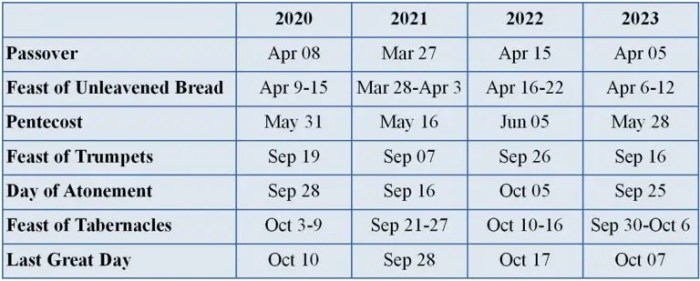
The High Holy Days are a series of religious observances that mark the Jewish New Year and the Day of Atonement. They are considered the most important holidays in the Jewish calendar and are a time for reflection, repentance, and renewal.
The High Holy Days begin with Rosh Hashanah, which is celebrated on the first and second days of the Hebrew month of Tishrei. Rosh Hashanah marks the beginning of the Jewish New Year and is a time to reflect on the past year and to make resolutions for the coming year.
The High Holy Days culminate with Yom Kippur, which is celebrated on the tenth day of Tishrei. Yom Kippur is a day of atonement and is a time to ask for forgiveness for one’s sins.
As we reflect on the significance of the IUIC High Holy Days 2023, let’s not forget the importance of professional development. Enhance your IT knowledge with CompTIA A+ 1102 PBQ dumps . These valuable resources will empower you to prepare effectively for your certification exam, ensuring your success in the tech industry while you continue to observe the spiritual aspects of the IUIC High Holy Days 2023.
Dates and Names of High Holy Days in 2023
| Date | Name |
|---|---|
| September 15-16, 2023 | Rosh Hashanah |
| September 24, 2023 | Yom Kippur |
Traditional Practices and Customs
There are a number of traditional practices and customs associated with the High Holy Days.
- Attending synagogue services:Jews typically attend synagogue services on Rosh Hashanah and Yom Kippur. These services include prayers, readings from the Torah, and sermons.
- Eating special foods:Certain foods are traditionally eaten on the High Holy Days. These foods include apples and honey on Rosh Hashanah, and brisket and challah on Yom Kippur.
- Wearing white clothing:Many Jews wear white clothing on Yom Kippur. This symbolizes purity and repentance.
- Fasting:Jews fast on Yom Kippur from sunset to sunset. This is a time to reflect on one’s sins and to ask for forgiveness.
Spiritual Reflection and Atonement
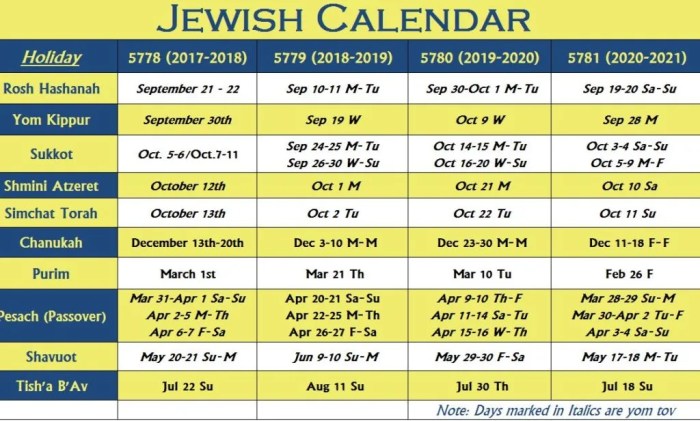
The High Holy Days serve as a time for profound spiritual reflection and atonement. During this period, individuals are encouraged to examine their actions, seek forgiveness, and strive for a deeper connection with God and others.
A central concept in the High Holy Days observance is “teshuvah” (repentance). Teshuvah is a multi-faceted process that involves acknowledging one’s mistakes, expressing remorse, and making a commitment to change one’s behavior. Through teshuvah, individuals can break free from negative patterns and move towards a more righteous path.
Meaningful Reflection and Atonement
- Introspection:Engage in deep self-reflection, examining one’s thoughts, words, and actions. Identify areas where improvement is needed.
- Prayer:Communicate with God through heartfelt prayers, expressing gratitude, seeking forgiveness, and asking for guidance.
- Charity:Extend acts of kindness and compassion to those in need, demonstrating a desire to make amends and repair relationships.
- Confession:Acknowledge one’s wrongdoings and seek forgiveness from those who have been wronged, taking responsibility for one’s actions.
- Commitment to Change:Make a conscious decision to change negative patterns, setting realistic goals and seeking support when necessary.
By engaging in these practices, individuals can engage in meaningful reflection and atonement during the High Holy Days, setting the stage for a year of growth, renewal, and spiritual connection.
Community and Connection
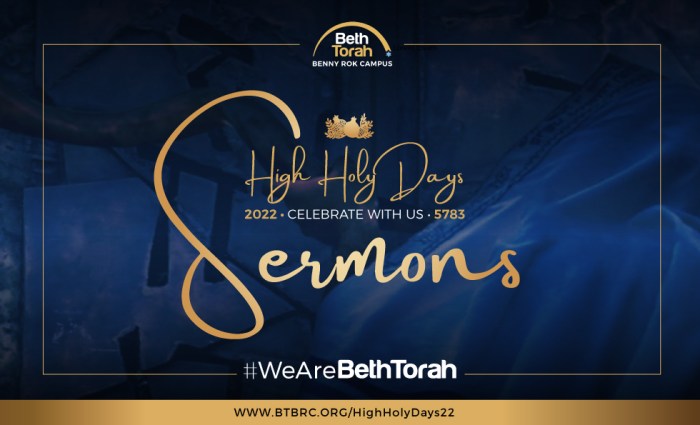
The High Holy Days are a time for reflection, atonement, and connection. Synagogues and Jewish organizations play a vital role in fostering a sense of community and belonging during this sacred period.
Synagogues offer a variety of gatherings and support systems for worshipers during the High Holy Days. These include communal prayer services, study sessions, and social events. These gatherings provide opportunities for worshipers to come together, share their experiences, and support each other on their spiritual journeys.
Community Gatherings
- Prayer services:The High Holy Days are marked by special prayer services that bring the community together. These services include the blowing of the shofar (ram’s horn), the reading of the Torah, and the chanting of traditional prayers.
- Study sessions:Many synagogues offer study sessions during the High Holy Days. These sessions provide opportunities for worshipers to learn about the meaning of the holidays and to explore their own spiritual beliefs.
- Social events:Synagogues and Jewish organizations often host social events during the High Holy Days. These events provide opportunities for worshipers to socialize and connect with each other outside of the synagogue setting.
Liturgical and Musical Traditions
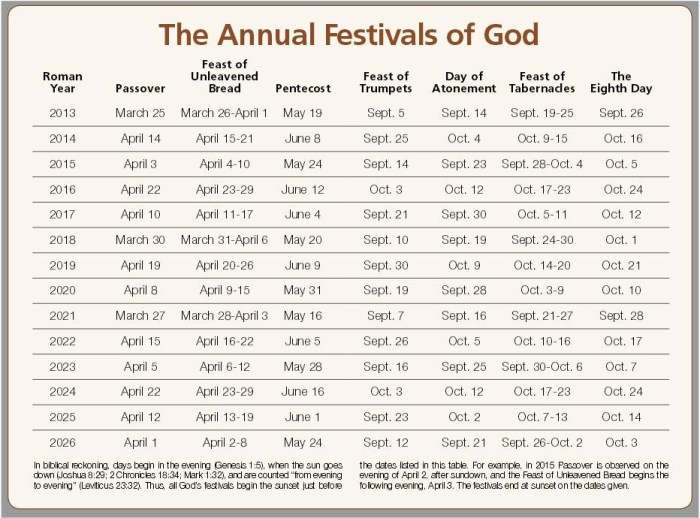
The High Holy Days are marked by a unique set of liturgical and musical traditions that contribute to their spiritual significance. These traditions have evolved over centuries, reflecting the rich cultural and religious heritage of the Jewish people.
High Holy Day prayers and services follow a structured format, with specific readings, prayers, and rituals performed at different times of the day. The central theme of these prayers is repentance, forgiveness, and the renewal of the covenant between God and the Jewish people.
Musical Traditions
Music plays a vital role in the High Holy Days, enhancing the emotional and spiritual impact of the services. Traditional melodies, known as nusach, are used to accompany the prayers, with each holiday having its own distinctive set of melodies.
The use of specific instruments is also significant. The shofar, a ram’s horn, is blown at key moments during the services, symbolizing the call to repentance and the binding of Isaac. The magen David, a triangular harp, is sometimes used to accompany the singing of certain prayers.
Musical arrangements vary depending on the community and the synagogue. Some synagogues favor a more traditional approach, while others incorporate contemporary elements into their services. The goal of all these musical traditions is to create an atmosphere of reverence, reflection, and connection with the divine.
Historical and Cultural Context
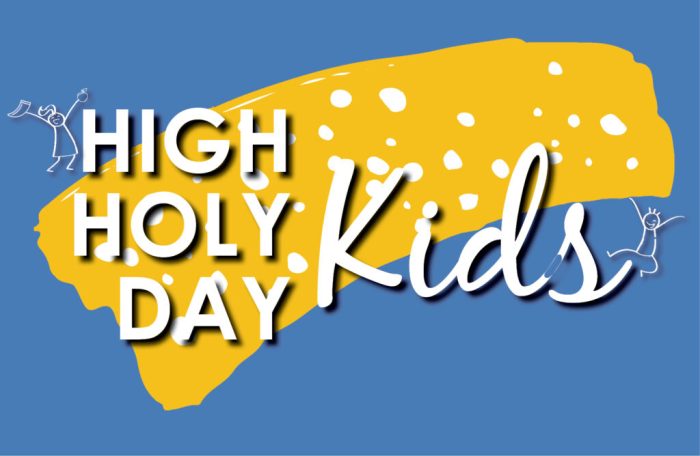
The High Holy Days, also known as the Days of Awe, have a rich and complex history deeply rooted in Jewish tradition. Their origins can be traced back to ancient Israel, where they were observed as days of repentance and atonement.Throughout
Jewish history, the High Holy Days have evolved and taken on new meanings. During the Second Temple period, they became associated with the destruction of the Temple and the Babylonian exile. After the exile, they were reestablished as days of communal mourning and reflection.
Denominational Differences
Different Jewish communities and denominations have shaped the traditions and practices associated with the High Holy Days. Orthodox Jews typically observe the High Holy Days with strict adherence to traditional rituals and customs. Conservative Jews blend traditional practices with modern interpretations, while Reform Jews emphasize the ethical and spiritual aspects of the holidays.
Historical Significance, Iuic high holy days 2023
The High Holy Days have played a significant role in Jewish history. They have served as a time for Jews to reflect on their past, present, and future, and to reaffirm their commitment to their faith. The Days of Awe have also been a time of persecution and oppression for Jews, as anti-Semitic violence often increased during this period.
Frequently Asked Questions
What are the dates of the IUIC High Holy Days 2023?
The IUIC High Holy Days 2023 begin on the evening of September 25th, 2023, and end on the evening of October 5th, 2023.
What is the significance of the High Holy Days in the Jewish calendar?
The High Holy Days are the most sacred and important holidays in the Jewish calendar. They are a time for reflection, atonement, and renewal, and they commemorate the creation of the world and the giving of the Torah to the Jewish people.
What are some traditional practices and customs associated with the High Holy Days?
Traditional practices and customs associated with the High Holy Days include fasting, attending synagogue services, praying, and spending time with family and friends.